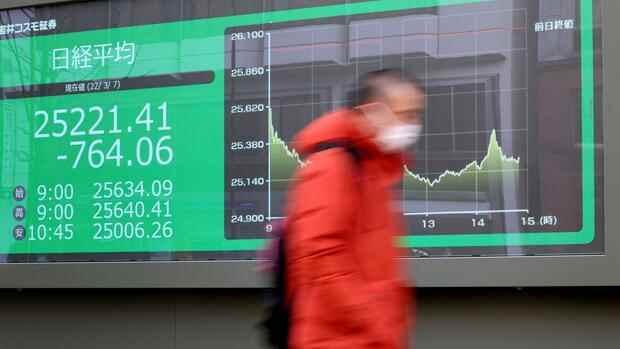The reason for the Asian price jumps were the previous day’s gains on the US markets.
(Photo: IMAGO/AFLO)
Tokyo, Shanghai, Seoul Strong price gains in the US also encouraged investors in Asia to place new bets. Japan’s Nikkei-225, which summarizes the price movements of 225 major companies, and the broad Topix, meanwhile, rose 3.9 percent. Ultimately, the Nikkei 225 was 25,667.85 points, 3.8 percent higher than in the morning at the lunch break. But the recovery did not stop at Japan’s borders.
After a public holiday, South Korea’s Kospi index welcomed the newly elected president, the conservative Yoon Suk Yeol, with a price jump of more than two percent. Singapore’s Straits Times Index also traded more than a percent higher than the previous day. The Hong Kong Hangseng index and the Shanghai Composite also opened nearly two percent higher.
The reason for this was the previous day’s gains on the US markets. There, investors had used small signs of hope in the Ukraine war and a drop in oil prices as a motive for renewed share purchases. The Dow Jones was driven by two percent to 33,286 points, the technology-oriented Nasdaq even by 3.6 percent to 13,255 points.
The relief was also reflected in the foreign exchange market. The yen, which is a safe haven in crises and usually rises, fell against many currencies — particularly the euro — in morning trade. The euro rose 1.4 percent to 128.23 yen in the first 90 minutes of trading. This was the strongest euro exchange rate for about a week.
Top jobs of the day
Find the best jobs now and
be notified by email.
Strategists warn against optimism
But the strategists at the major bank ING warned their Asian customers: “The basis for this optimism is actually pretty thin.” Talks are taking place between Russia and Ukraine, and Ukrainian President Volodymyr Zelensky had indicated that he was ready to compromise. But voices from the Gulf countries that they might produce more oil in order to slow global price increases have already been put into perspective. It is therefore unlikely that the oil price would fall again permanently. At the same time, trading is thin as many long-term investors wait and see. “The price rally remains vulnerable to a reversal as risks remain,” it concluded.
>> Read here: Brilliant bear market rally – Dax closes more than 1000 points higher
Concern about the economy is growing in Japan
In Japan, too, investors fear that the rapid rise in oil prices will drive inflation up and growth down. Japan, after all, imports 99 percent of its oil and gas consumption and 86 percent of its wheat consumption. The economists at MUFG lowered their growth forecast for the current calendar year from 2.9 to 2.3 percent.
But they also had good news: “The risk of a stagflation shock for private households is lower in Japan than in Europe,” according to the economists. Economists understand stagflation as a situation in which the economy stagnates or shrinks, but at the same time prices rise and thus reduce purchasing power.
According to Japanese economists, the rise in oil and wheat prices will push Japan’s inflation rate to two percent in the short term. But they believe that the price explosion of these three products alone will not be enough to push Japan’s inflation rate to three or four percent.
Bonds and FX remain volatile
The bond markets are apparently already anticipating rising interest rates. US 10-year Treasuries rose 0.107 percentage points to 1.953 percent on Wednesday, while the Japanese equivalent rose 0.015 percentage points to 0.175 percent. That was the highest value since early March.
The price of oil fell sharply. The price of Dubai crude oil, the key price indicator for Asia, fell 12.3 percent to $111.70 on Thursday morning in Asia. Even the gold price in Japan fell 4.9 percent in the past 24 hours to 7,364 yen (57.41 euros) per gram.
More: Why a state bankruptcy in Russia can hardly be avoided
